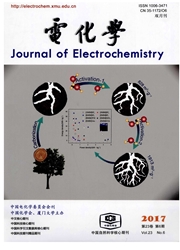

 中文摘要:
中文摘要:
应用恒电位在金基底表面电化学沉积纳米金,通过Au—S键将巯基修饰DNA探针固定在纳米金表面,与互补靶序列杂交,构建计时库仑电化学DNA传感器,并检测急性早幼粒细胞白血病(APL)PML/RARα融合基因.采用扫描电子显微术(SEM)与电化学交流阻抗技术(EIS)观察纳米金和表征DNA传感器的构筑过程.以氯化六氨合钌([Ru(NH3)6]Cl3,RuHex)作电化学杂交指示剂,由计时库仑法检测人工合成APL的PML/RARα融合基因.结果表明,纳米金能放大RuHex检测信号,杂交前后电量差值(ΔQ)与靶标链DNA浓度的对数(lgC)值在1.0×10-13~1.0×10-9mol.L-1范围内呈线性关系,检出下限3.7×10-14mol.L-1(S/N=3).该法操作简便、特异性好,有望用于实际样品的检测.
 英文摘要:
英文摘要:
A gold nanoparticles modified electrode was prepared by electrodeposition at constant potential. The sulfydryl modified probe was immobilized onto surface of gold nanoparticles via Au--S covalent bond and hybrid- ized with complementary target DNA sequences, then the DNA sensor was fabricated for the detection of PML/ RARα fusion gene by chronocoulometry in acute promyelocytic leukemia (APL). Scanning electron microscopy (SEM) and electrochemical impedance spectroscopy (EIS) were used to characterize the surface morphology of gold nanoparticles and the constructing process of sensor. With hexaammineruthenium ( Ⅲ ) chloride (RuHex) as a novel electrochemical indicator, the chronocoulometric DNA biosensor was employed to monitor artificial APL PML/RARα fusion gene fragment. Experimental results showed that gold nanoparticles amplified the detection signal of RuHex. The linear relationship between the charge difference in the RuHex after and before hybridiza- tion and logarithmic concentrations(lgC) of target sequence was observed in the concentration range of 1.0 × 10-13 -1.0 × 10-9 mol L-1 ,and the detection limit had been estimated to be 3.7 ×10-14 mol L-1 (S/N = 3 ). This approach is simple, has good specificity, and is promising to apply for the detection of APL in the real sample for medical diagnostics.
 同期刊论文项目
同期刊论文项目
 同项目期刊论文
同项目期刊论文
 Study of the electrochemical behavior of isorhamnetin on a glassy carbon electrode and its applicati
Study of the electrochemical behavior of isorhamnetin on a glassy carbon electrode and its applicati On-line Screening and identification of Radical Scavenging Compounds Extracted from Flos Lonicerae b
On-line Screening and identification of Radical Scavenging Compounds Extracted from Flos Lonicerae b Electrochemical Biosensor for Detection of BCR/ABL Fusion Gene Using Locked Nucleic Acids on 4-Amino
Electrochemical Biosensor for Detection of BCR/ABL Fusion Gene Using Locked Nucleic Acids on 4-Amino Simultaneous voltammetric determination of norepinephrine, ascorbic acid and uric acid on polycalcon
Simultaneous voltammetric determination of norepinephrine, ascorbic acid and uric acid on polycalcon Studies of the interaction between Aloe-emodin and DNA and preparation of DNA biosensor for detectio
Studies of the interaction between Aloe-emodin and DNA and preparation of DNA biosensor for detectio Electrocatalytical properties ofbergenin on a multi-wall carbon nanotubes modified carbon paste elec
Electrocatalytical properties ofbergenin on a multi-wall carbon nanotubes modified carbon paste elec Electrochemical oxidation of luteolin at a glassy carbon electrode and its application in pharmaceut
Electrochemical oxidation of luteolin at a glassy carbon electrode and its application in pharmaceut Selective oxidation of serotonin and norepinephrine over eriochrome cyanine R film modified glassy c
Selective oxidation of serotonin and norepinephrine over eriochrome cyanine R film modified glassy c Electrochemical biosensor for detection of BCR/ABL fusion gene based on hairpin locked nucleic acids
Electrochemical biosensor for detection of BCR/ABL fusion gene based on hairpin locked nucleic acids An electrochemical biosensor for detection of PML-RARA fusion gene using capture probe covalently im
An electrochemical biosensor for detection of PML-RARA fusion gene using capture probe covalently im 期刊信息
期刊信息
